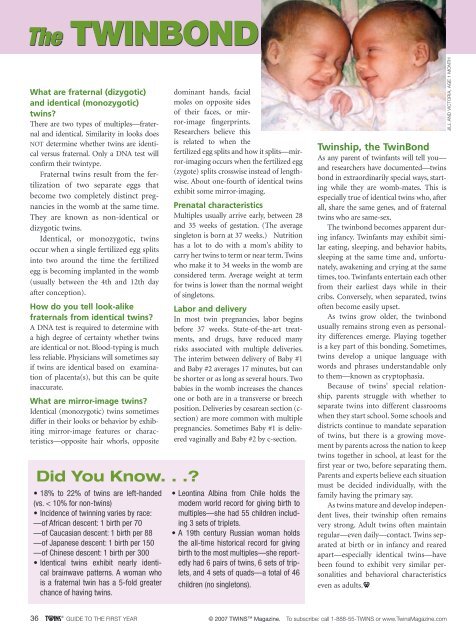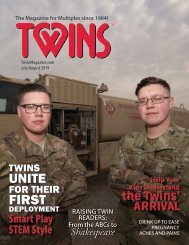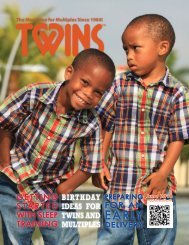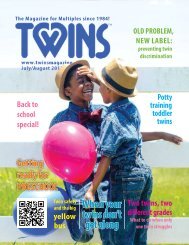2007GuideToTheFirstYear
Create successful ePaper yourself
Turn your PDF publications into a flip-book with our unique Google optimized e-Paper software.
The TWINBOND<br />
What are fraternal (dizygotic)<br />
and identical (monozygotic)<br />
twins?<br />
There are two types of multiples—fraternal<br />
and identical. Similarity in looks does<br />
NOT determine whether twins are identical<br />
versus fraternal. Only a DNA test will<br />
confirm their twintype.<br />
Fraternal twins result from the fertilization<br />
of two separate eggs that<br />
become two completely distinct pregnancies<br />
in the womb at the same time.<br />
They are known as non-identical or<br />
dizygotic twins.<br />
Identical, or monozygotic, twins<br />
occur when a single fertilized egg splits<br />
into two around the time the fertilized<br />
egg is becoming implanted in the womb<br />
(usually between the 4th and 12th day<br />
after conception).<br />
How do you tell look-alike<br />
fraternals from identical twins?<br />
A DNA test is required to determine with<br />
a high degree of certainty whether twins<br />
are identical or not. Blood-typing is much<br />
less reliable. Physicians will sometimes say<br />
if twins are identical based on examination<br />
of placenta(s), but this can be quite<br />
inaccurate.<br />
What are mirror-image twins?<br />
Identical (monozygotic) twins sometimes<br />
differ in their looks or behavior by exhibiting<br />
mirror-image features or characteristics—opposite<br />
hair whorls, opposite<br />
Did You Know. . .?<br />
• 18% to 22% of twins are left-handed<br />
(vs. < 10% for non-twins)<br />
• Incidence of twinning varies by race:<br />
—of African descent: 1 birth per 70<br />
—of Caucasian descent: 1 birth per 88<br />
—of Japanese descent: 1 birth per 150<br />
—of Chinese descent: 1 birth per 300<br />
• Identical twins exhibit nearly identical<br />
brainwave patterns. A woman who<br />
is a fraternal twin has a 5-fold greater<br />
chance of having twins.<br />
dominant hands, facial<br />
moles on opposite sides<br />
of their faces, or mirror-image<br />
fingerprints.<br />
Researchers believe this<br />
is related to when the<br />
fertilized egg splits and how it splits—mirror-imaging<br />
occurs when the fertilized egg<br />
(zygote) splits crosswise instead of lengthwise.<br />
About one-fourth of identical twins<br />
exhibit some mirror-imaging.<br />
Prenatal characteristics<br />
Multiples usually arrive early, between 28<br />
and 35 weeks of gestation. (The average<br />
singleton is born at 37 weeks.) Nutrition<br />
has a lot to do with a mom's ability to<br />
carry her twins to term or near term. Twins<br />
who make it to 34 weeks in the womb are<br />
considered term. Average weight at term<br />
for twins is lower than the normal weight<br />
of singletons.<br />
Labor and delivery<br />
In most twin pregnancies, labor begins<br />
before 37 weeks. State-of-the-art treatments,<br />
and drugs, have reduced many<br />
risks associated with multiple deliveries.<br />
The interim between delivery of Baby #1<br />
and Baby #2 averages 17 minutes, but can<br />
be shorter or as long as several hours. Two<br />
babies in the womb increases the chances<br />
one or both are in a transverse or breech<br />
position. Deliveries by cesarean section (csection)<br />
are more common with multiple<br />
pregnancies. Sometimes Baby #1 is delivered<br />
vaginally and Baby #2 by c-section.<br />
• Leontina Albina from Chile holds the<br />
modern world record for giving birth to<br />
multiples—she had 55 children including<br />
3 sets of triplets.<br />
• A 19th century Russian woman holds<br />
the all-time historical record for giving<br />
birth to the most multiples—she reportedly<br />
had 6 pairs of twins, 6 sets of triplets,<br />
and 4 sets of quads—a total of 46<br />
children (no singletons).<br />
Twinship, the TwinBond<br />
As any parent of twinfants will tell you—<br />
and researchers have documented—twins<br />
bond in extraordinarily special ways, starting<br />
while they are womb-mates. This is<br />
especially true of identical twins who, after<br />
all, share the same genes, and of fraternal<br />
twins who are same-sex.<br />
The twinbond becomes apparent during<br />
infancy. Twinfants may exhibit similar<br />
eating, sleeping, and behavior habits,<br />
sleeping at the same time and, unfortunately,<br />
awakening and crying at the same<br />
times, too. Twinfants entertain each other<br />
from their earliest days while in their<br />
cribs. Conversely, when separated, twins<br />
often become easily upset.<br />
As twins grow older, the twinbond<br />
usually remains strong even as personality<br />
differences emerge. Playing together<br />
is a key part of this bonding. Sometimes,<br />
twins develop a unique language with<br />
words and phrases understandable only<br />
to them—known as cryptophasia.<br />
Because of twins' special relationship,<br />
parents struggle with whether to<br />
separate twins into different classrooms<br />
when they start school. Some schools and<br />
districts continue to mandate separation<br />
of twins, but there is a growing movement<br />
by parents across the nation to keep<br />
twins together in school, at least for the<br />
first year or two, before separating them.<br />
Parents and experts believe each situation<br />
must be decided individually, with the<br />
family having the primary say.<br />
As twins mature and develop independent<br />
lives, their twinship often remains<br />
very strong. Adult twins often maintain<br />
regular—even daily—contact. Twins separated<br />
at birth or in infancy and reared<br />
apart—especially identical twins—have<br />
been found to exhibit very similar personalities<br />
and behavioral characteristics<br />
even as adults.<br />
JILL AND VICTORIA, AGE 1 MONTH<br />
36 GUIDE TO THE FIRST YEAR © 2007 TWINS Magazine. To subscribe: call 1-888-55-TWINS or www.TwinsMagazine.com


















